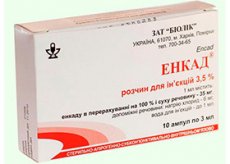Medical expert of the article
New publications
Preparations
Enkad
Last reviewed: 04.07.2025

All iLive content is medically reviewed or fact checked to ensure as much factual accuracy as possible.
We have strict sourcing guidelines and only link to reputable media sites, academic research institutions and, whenever possible, medically peer reviewed studies. Note that the numbers in parentheses ([1], [2], etc.) are clickable links to these studies.
If you feel that any of our content is inaccurate, out-of-date, or otherwise questionable, please select it and press Ctrl + Enter.

Enkad helps to eliminate the deficiency of nucleic acids that occurs in the body.
The drug helps regulate tissue metabolism of nucleotides, and at the same time demonstrates a pronounced immunomodulatory effect. It also helps improve the activity of cell walls and muscle bioenergetics. In addition, the drug weakens myodystrophic processes occurring inside the body, and helps conduct impulses inside motor neurons.
Indications Encada
It is used in case of development of diseases affecting the retina (hereditary). Among them is degeneration, which has a tapetoretinal form (retinal abiotrophy - damage to the retina caused by a disorder of its nutritional processes).
Release form
The medicinal substance is released in the form of a lyophilisate; 3.5% injection liquid (pH values are within 4.5-6.0) inside ampoules with a capacity of 2 or 3 ml. There are 10 such ampoules inside the box.
Dosing and administration
The medication must be used intramuscularly or subconjunctivally, and also through the procedure of phonophoresis (therapeutic agents are administered using ultrasound through intact mucous membranes) and through local applications.
For daily intramuscular injections, an adult needs to take 175-210 mg per day (equivalent to 5-6 ml of 3.5% liquid). For a child under 7 years old, the daily dose is calculated as 10 mg/year of life; for a child over 7 years old – 10.5 mg (equivalent to 3 ml of liquid) per day.
The daily dosage is administered in 2 doses with a 5-6 hour interval between them.
The therapeutic cycle should last 15 days. The treatment should be repeated with 6-8-10 month breaks, but at least once a year.
In addition to intramuscular injections, subconjunctival administration of the drug is also allowed - 0.3 ml of 3.5% liquid (equivalent to 10.5 mg), 1 time per day, over a period of 10-15 days.
Phonophoresis procedures use 0.5% Enkada liquid. The medicinal solution must be prepared immediately before the procedure. Treatment courses include 10-12 daily procedures; such courses must be taken twice a year.
There is information regarding the use of the drug in the case of Sjogren's disease. It is believed that the positive therapeutic effect in this case is due to the immunomodulatory effect that the drug provides.
In case of treatment of the above pathology, the drug is used in the form of applications to the oral mucosa. In such procedures, a 1% solution (5 ml) is used. The procedure lasts 20 minutes. Before use, the 3.5% liquid must be dissolved in isotonic NaCl (in a ratio of 1 to 3.5). Applications must be performed 3 times a day (after eating) for a period of 2 weeks. 3-4 such cycles are performed per year.
 [ 6 ]
[ 6 ]
Use Encada during pregnancy
Do not use Encad if you are breastfeeding or pregnant.
Contraindications
Among the contraindications:
- having an active form of infectious diseases (including tuberculosis);
- viral pathologies;
- neoplasms;
- diseases associated with the functioning of the cardiovascular system or central nervous system (in severe degrees);
- renal/hepatic dysfunction;
- pathologies of allergic origin;
- use in the elderly.
Side effects Encada
After an intramuscular injection of the drug, the temperature may increase, joint pain or chills may appear, as well as other allergy symptoms. In such cases, the drug is discontinued, and the patient undergoes desensitizing treatment.
In order to prevent the occurrence of severe side effects, before starting therapy, it is necessary to perform an intradermal test (subcutaneously inject 0.1 ml of 3.5% liquid of the drug into the area of the lower third of the forearm (on the inside of the arm)). If a papule with a diameter of more than 1 cm appears in this area after 24 hours from the moment of administration, the test is considered to be positive - in this case, the drug cannot be used.
If the test gives a negative result, therapy can begin.
In case of subconjunctival application, hyperemia or swelling in the conjunctival area may be observed, which can be relieved by instillation of a GCS substance. Pain and enlargement of the lymph nodes in the cervical and parotid region may also be observed.
Storage conditions
Enkad must be stored at temperatures in the range of +4/+10°C.
Shelf life
Encad can be used within a 2-year period from the date of manufacture of the pharmaceutical product.
Analogues
Analogues of the drug are the drugs Peloidodistilate and Actovegin, with Placenta extract, as well as Thiogama with Aloe extract.
Reviews
Encad generally receives good reviews from patients who have used it, but in some cases it has been reported that it can cause negative symptoms.
Attention!
To simplify the perception of information, this instruction for use of the drug "Enkad" translated and presented in a special form on the basis of the official instructions for medical use of the drug. Before use read the annotation that came directly to medicines.
Description provided for informational purposes and is not a guide to self-healing. The need for this drug, the purpose of the treatment regimen, methods and dose of the drug is determined solely by the attending physician. Self-medication is dangerous for your health.

